The global inductive arc position sensor market will expand from USD 557.7 million in 2025 to USD 1,747.7 million by 2035, advancing at a CAGR of 12.1% and growing by nearly 3.13X. The strong trajectory is anchored by simultaneous shifts on both the supply and demand sides, with technology upgrades and application diversification driving equilibrium.
On the supply side, manufacturers are focusing on advanced miniaturization techniques, high-frequency coil designs, and improved electromagnetic shielding to deliver higher accuracy and stable performance under challenging industrial conditions. Suppliers are increasingly investing in automated production facilities to handle the scaling requirements of automotive OEMs and robotics integrators, where batch precision and cost efficiency are critical. Component sourcing, especially copper windings, magnetic alloys, and semiconductor chips, remains a strategic area of concern, with global supply chains attempting to balance cost pressures against performance specifications. Partnerships between sensor producers and system integrators are expanding, allowing suppliers to capture higher value by embedding sensors into broader automation and automotive control systems.
On the demand side, automotive applications represent the strongest pull, particularly with electric vehicles and advanced driver assistance systems that require accurate, contactless measurement of throttle position, steering angle, and motor feedback. Industrial automation is another core driver, with machinery operators shifting from contact-based encoders to inductive arc position sensors for improved longevity and reduced maintenance. Robotics, particularly in medical and collaborative platforms, is accelerating adoption, as the need for reliable position feedback under dynamic load conditions intensifies. Demand is also rising within medical device manufacturing for compact and durable sensing systems that ensure consistent quality in high-precision assembly lines.
Demand is outpacing supply in certain application clusters, leading to intensified competition among suppliers to expand production capacity and innovate through differentiation. Automotive OEMs are increasingly seeking long-term contracts to secure stable sensor supply, while industrial users emphasize lifecycle costs and integration with IoT-enabled monitoring platforms.
Between 2025 and 2030, the inductive arc position sensor market is projected to expand from USD 557.7 million to USD 880.7 million, resulting in a value increase of USD 323.0 million, which represents 27.1% of the total forecast growth for the decade. This phase of development will be shaped by increasing adoption of advanced automotive electronics, rising demand for high-resolution position sensing capabilities, and growing emphasis on contactless measurement systems with enhanced accuracy characteristics. Sensor manufacturers are expanding their product portfolios to address the growing demand for automotive safety applications, industrial automation requirements, and precision measurement solutions.
| Metric | Value |
|---|---|
| Estimated Value in (2025E) | USD 557.7 million |
| Forecast Value in (2035F) | USD 1,747.7 million |
| Forecast CAGR (2025 to 2035) | 12.1% |
From 2030 to 2035, the inductive arc position sensor market is forecast to grow from USD 880.7 million to USD 1,747.7 million, adding another USD 867.0 million, which constitutes 72.9% of the overall ten-year expansion. This period is expected to be characterized by the expansion of electric vehicle technologies, the integration of ai-powered sensing systems, and the development of multi-axis position sensing platforms with enhanced precision capabilities. The growing adoption of Industry 4.0 practices will drive demand for inductive arc position sensors with superior accuracy systems and compatibility with IoT-enabled manufacturing equipment across industrial automation applications.
Between 2020 and 2025, the inductive arc position sensor market experienced robust growth, driven by increasing demand for advanced automotive electronics and growing recognition of contactless sensing technology as essential components for precision measurement across automotive steering systems, industrial robotics, and medical device applications. The inductive arc position sensor market developed as manufacturers recognized the potential for inductive sensors to provide reliable position feedback while maintaining electromagnetic immunity and enabling accurate measurement protocols. Technological advancement in signal processing algorithms and precision sensing mechanisms began emphasizing the critical importance of maintaining measurement accuracy and repeatability in demanding industrial environments.
Market expansion is being supported by the increasing global demand for precision sensing solutions and the corresponding need for contactless measurement systems that can provide superior accuracy and reliability while enabling reduced mechanical wear and electromagnetic interference resistance across various automotive, industrial, and medical device applications. Modern automotive manufacturers and industrial automation specialists are increasingly focused on implementing sensor technologies that can deliver precise position feedback, prevent system failures, and provide consistent measurement performance throughout harsh operating conditions and diverse environmental challenges. Inductive arc position sensors' proven ability to deliver exceptional accuracy against electromagnetic interference, enable maintenance-free operations, and support precise angular measurement protocols make them essential components for contemporary automotive and industrial automation systems.
The growing emphasis on automotive safety and industrial precision is driving demand for inductive arc position sensors that can support advanced driver assistance systems, improve manufacturing process control, and enable automated positioning applications. Manufacturers' preference for technology that combines reliable position sensing with operational durability and electromagnetic compatibility is creating opportunities for innovative sensor implementations. The rising influence of electric vehicle technology and smart manufacturing practices is also contributing to increased demand for inductive arc position sensors that can provide high-resolution measurements, real-time position feedback, and reliable performance across extended operational periods.
The inductive arc position sensor market is poised for rapid growth and transformation. As industries across automotive, industrial automation, medical devices, and aerospace seek solutions that deliver exceptional measurement precision, electromagnetic immunity, and operational reliability, inductive arc position sensors are gaining prominence not just as sensing components but as strategic enablers of advanced control systems and precision measurement applications.
Rising electric vehicle adoption in Asia-Pacific and expanding Industry 4.0 initiatives globally amplify demand, while manufacturers are leveraging innovations in signal processing algorithms, contactless sensing technologies, and integrated electronics systems.
Pathways like high-resolution sensing platforms, multi-axis measurement systems, and specialized automotive applications promise strong margin uplift, especially in premium vehicle and precision manufacturing segments. Geographic expansion and technology integration will capture volume, particularly where local manufacturing capabilities and automotive technology adoption are critical. Regulatory support around automotive safety standards, industrial automation requirements, and precision measurement compliance give structural support.
The inductive arc position sensor market is segmented by classification, application, technology type, end-use sector, and region. By classification, the market is divided into self-sensing and mutual inductance categories. By application, it covers the automobile, industry, medical care, and others. By technology type, the market includes digital output, analog output, and programmable interface systems. By end-use sector, it is categorized into automotive manufacturers, industrial automation, medical device companies, and aerospace applications. Regionally, the market is divided into North America, Europe, East Asia, South Asia & Pacific, Latin America, and the Middle East & Africa.
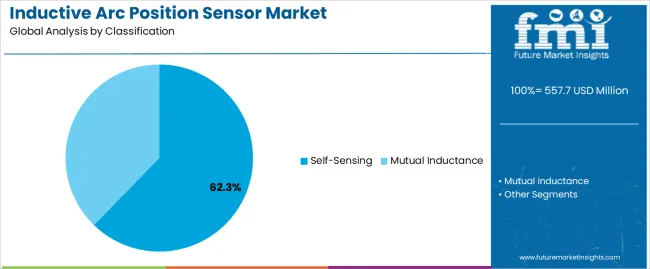
The self-sensing segment is projected to account for 62.3% of the inductive arc position sensor market in 2025, reaffirming its position as the leading classification category. Automotive manufacturers and industrial automation specialists increasingly utilize self-sensing inductive position sensors for their superior signal-to-noise ratio capabilities when operating in electromagnetic interference environments, excellent measurement stability characteristics, and cost-effectiveness in applications ranging from automotive steering systems to industrial positioning control. Self-sensing inductive arc position sensor technology's advanced signal processing capabilities and simplified circuit design directly address the industrial requirements for reliable position feedback in demanding operational environments.
This classification segment forms the foundation of modern automotive electronics systems, as it represents the sensor type with the greatest electromagnetic immunity and established market demand across multiple application categories and industrial sectors. Manufacturer investments in enhanced signal processing algorithms and integrated electronics compatibility continue to strengthen adoption among automotive suppliers and industrial equipment manufacturers. With companies prioritizing measurement reliability and electromagnetic compatibility, self-sensing inductive arc position sensors align with both performance requirements and cost optimization objectives, making them the central component of comprehensive position sensing strategies.
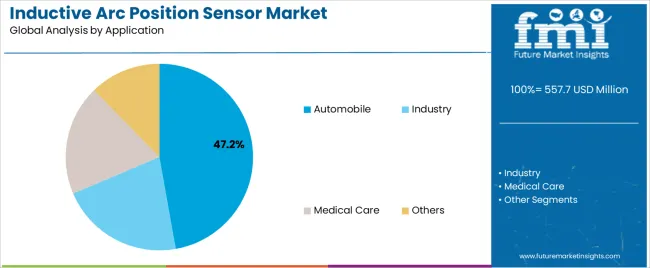
Automobile applications are projected to represent 47.2% of inductive arc position sensor demand in 2025, underscoring their critical role as the primary automotive consumers of precision sensing technology for steering systems, throttle position control, and advanced driver assistance applications. Automotive manufacturers prefer inductive arc position sensors for their exceptional electromagnetic immunity capabilities, maintenance-free operational characteristics, and ability to provide accurate position feedback while ensuring reliable performance throughout diverse automotive operating conditions. Positioned as essential components for modern vehicle systems, inductive arc position sensors offer both precision advantages and durability benefits.
The segment is supported by continuous innovation in automotive electronics technologies and the growing availability of specialized sensing systems that enable high-resolution measurements with enhanced temperature stability and rapid response capabilities. The automotive manufacturers are investing in advanced sensor integration systems to support comprehensive vehicle automation and safety applications. As electric vehicle demand becomes more prevalent and automotive safety requirements increase, automobile applications will continue to dominate the end-use market while supporting advanced automotive electronics utilization and precision control strategies.
The inductive arc position sensor market is advancing rapidly due to increasing demand for precision sensing technologies and growing adoption of contactless measurement solutions that provide superior accuracy and electromagnetic immunity while enabling reliable position feedback across diverse automotive, industrial, and medical device applications. The inductive arc position sensor market faces challenges, including higher initial costs compared to resistive sensors, complex signal processing requirements, and the need for specialized design expertise and electromagnetic compatibility considerations. Innovation in digital signal processing and integrated electronics continues to influence product development and market expansion patterns.
The growing adoption of electric vehicles, autonomous driving technologies, and advanced driver assistance systems is enabling manufacturers to produce sophisticated inductive arc position sensors with superior measurement capabilities, enhanced electromagnetic immunity, and integrated diagnostic functionalities. Advanced automotive sensing systems provide improved position accuracy while allowing more precise vehicle control and consistent performance across various operating conditions and environmental challenges. Manufacturers are increasingly recognizing the competitive advantages of high-resolution sensor capabilities for automotive differentiation and premium market positioning.
Modern inductive arc position sensor producers are incorporating IoT connectivity, predictive maintenance capabilities, and integrated condition monitoring systems to enhance operational intelligence, enable proactive maintenance strategies, and deliver value-added solutions to industrial customers. These technologies improve manufacturing efficiency while enabling new operational capabilities, including real-time position monitoring, measurement validation tracking, and reduced operational complexity. Advanced system integration also allows manufacturers to support comprehensive automation systems and industrial modernization beyond traditional mechanical positioning approaches.
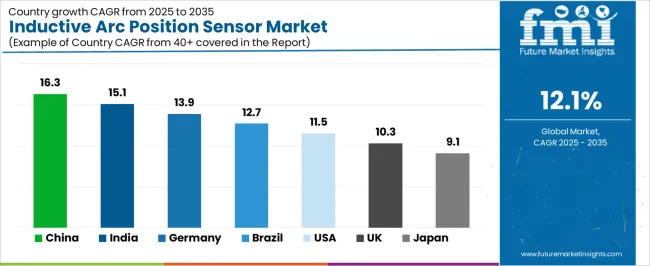
| Country | CAGR (2025-2035) |
|---|---|
| China | 16.3 |
| India | 15.1 |
| Germany | 13.9 |
| Brazil | 12.7 |
| USA | 11.5 |
| UK | 10.3 |
| Japan | 9.1% |
The inductive arc position sensor market is experiencing strong growth globally, with China leading at a 16.3% CAGR through 2035, driven by the expanding automotive electronics manufacturing, growing electric vehicle production, and significant investment in industrial automation technology development. India follows at 15.1%, supported by government initiatives promoting automotive manufacturing, increasing industrial automation demand, and growing precision sensing requirements. Germany shows growth at 13.9%, emphasizing automotive technology innovation and advanced manufacturing system development. Brazil records 12.7%, focusing on automotive industry expansion and industrial modernization programs. The USA demonstrates 11.5% growth, prioritizing automotive safety standards and industrial automation excellence. The UK exhibits 10.3% growth, emphasizing automotive technology development and precision manufacturing advancement. Japan shows 9.1% growth, supported by automotive electronics innovation and precision technology concentration.
The report covers an in-depth analysis of 40+ countries, Top-performing countries are highlighted below.
Revenue from inductive arc position sensors in China is projected to exhibit exceptional growth with a CAGR of 16.3% through 2035, driven by expanding automotive electronics manufacturing and rapidly growing electric vehicle production supported by government initiatives promoting automotive technology development. The country's strong position in sensor manufacturing and increasing investment in smart manufacturing infrastructure are creating substantial demand for advanced inductive arc position sensor solutions. Major automotive manufacturers and electronics companies are establishing comprehensive sensor production capabilities to serve both domestic automotive demand and industrial automation markets.
Revenue from inductive arc position sensors in India is expanding at a CAGR of 15.1%, supported by the country's growing automotive manufacturing sector, expanding government support for industrial modernization, and increasing adoption of precision sensing solutions. The country's initiatives promoting automotive technology and growing manufacturer awareness are driving requirements for advanced position measurement capabilities. International suppliers and domestic manufacturers are establishing extensive production and service capabilities to address the growing demand for inductive arc position sensor products.
Revenue from inductive arc position sensors in Germany is expanding at a CAGR of 13.9%, supported by the country's advanced automotive technology capabilities, strong emphasis on manufacturing innovation, and robust demand for high-performance sensing systems in automotive and industrial applications. The nation's mature automotive sector and precision-focused operations are driving sophisticated inductive arc position sensor systems throughout the manufacturing industry. Leading manufacturers and technology providers are investing extensively in advanced sensing technologies and electromagnetic compatibility solutions to serve both domestic and international markets.
Revenue from inductive arc position sensors in Brazil is growing at a CAGR of 12.7%, driven by the country's expanding automotive industry, growing manufacturing operations, and increasing investment in industrial technology development. Brazil's automotive manufacturing base and commitment to industrial modernization are supporting demand for efficient inductive arc position sensor solutions across multiple automotive production segments. Manufacturers are establishing comprehensive service capabilities to serve the growing domestic market and automotive export opportunities.
Revenue from inductive arc position sensors in the USA is expanding at a CAGR of 11.5%, supported by the country's advanced automotive technology sector, strategic focus on manufacturing efficiency, and established industrial automation capabilities. The USA's automotive innovation leadership and technology integration are driving demand for inductive arc position sensors in automotive safety systems, precision manufacturing, and industrial automation applications. Manufacturers are investing in comprehensive technology development to serve both domestic automotive markets and international specialty applications.
Revenue from inductive arc position sensors in the UK is growing at a CAGR of 10.3%, driven by the country's focus on automotive technology advancement, emphasis on manufacturing efficiency, and strong position in precision sensing development. The UK's established automotive innovation capabilities and commitment to manufacturing modernization are supporting investment in advanced sensing technologies throughout major automotive regions. Industry leaders are establishing comprehensive technology integration systems to serve domestic automotive operations and specialty manufacturing applications.
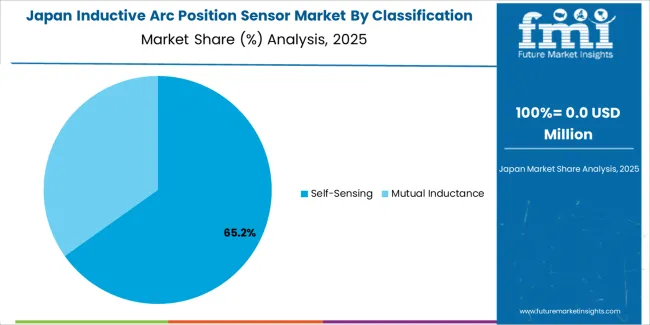
Revenue from inductive arc position sensors in Japan is expanding at a CAGR of 9.1%, supported by the country's automotive electronics initiatives, growing precision manufacturing sector, and strategic emphasis on sensor technology development. Japan's advanced technology capabilities and integrated automotive systems are driving demand for sophisticated inductive arc position sensors in automotive applications, precision manufacturing, and high-performance sensing applications. Leading manufacturers are investing in specialized capabilities to serve the stringent requirements of automotive electronics and precision sensing industries.
The inductive arc position sensor market in Europe is projected to grow from USD 111.5 million in 2025 to USD 311.4 million by 2035, registering a CAGR of 10.8% over the forecast period. Germany is expected to maintain its leadership position with a 38.7% market share in 2025, declining slightly to 37.9% by 2035, supported by its strong automotive electronics sector, advanced manufacturing technology capabilities, and comprehensive industrial automation industry serving diverse inductive arc position sensor applications across Europe.
France follows with a 17.8% share in 2025, projected to reach 18.3% by 2035, driven by robust demand for inductive arc position sensors in automotive manufacturing, industrial automation programs, and precision sensing applications, combined with established automotive technology infrastructure and electronics expertise. The United Kingdom holds a 15.2% share in 2025, expected to reach 15.7% by 2035, supported by strong automotive technology sector and growing precision manufacturing activities. Italy commands a 11.9% share in 2025, projected to reach 12.2% by 2035, while Spain accounts for 8.4% in 2025, expected to reach 8.7% by 2035. The Netherlands maintains a 4.2% share in 2025, growing to 4.4% by 2035. The Rest of Europe region, including Nordic countries, Eastern Europe, Belgium, Poland, and other nations, is anticipated to maintain momentum, with its collective share moving from 3.8% to 2.8% by 2035, attributed to increasing automotive manufacturing in Eastern Europe and growing precision sensing penetration in Nordic countries implementing advanced automotive technology programs.
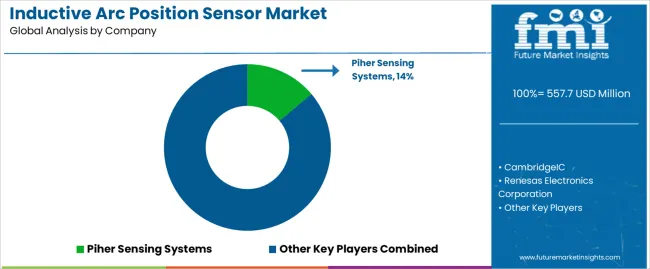
The inductive arc position sensor market is characterized by competition among established sensor manufacturers, specialized automotive electronics producers, and integrated measurement solutions providers. Companies are investing in signal processing technology research, electromagnetic immunity optimization, precision sensing system development, and comprehensive product portfolios to deliver consistent, high-performance, and application-specific inductive arc position sensor solutions. Innovation in digital signal processing, integrated electronics systems, and measurement accuracy enhancement is central to strengthening market position and competitive advantage.
Piher Sensing Systems leads the inductive arc position sensor market with a strong market share, offering comprehensive inductive arc position sensor solutions including advanced signal processing systems with a focus on automotive and industrial applications. CambridgeIC provides specialized sensing technologies with an emphasis on high-resolution measurement systems and electromagnetic immunity optimization. Renesas Electronics Corporation delivers innovative semiconductor-based sensor products with a focus on automotive electronics platforms and integrated system solutions. Microchip Technology specializes in sensor interface technologies and integrated circuit solutions for precision measurement applications. Premier Farnell focuses on sensor distribution and comprehensive sensing solutions. Melexis offers specialized automotive sensor platforms with emphasis on magnetic sensing and position measurement applications.
| Items | Values |
|---|---|
| Quantitative Units (2025) | USD 557.7 million |
| Classification | Self-Sensing, Mutual Inductance |
| Application | Automobile, Industry, Medical Care, Others |
| Technology Type | Digital Output, Analog Output, Programmable Interface Systems |
| End-Use Sector | Automotive Manufacturers, Industrial Automation, Medical Device Companies, Aerospace Applications |
| Regions Covered | North America, Europe, East Asia, South Asia & Pacific, Latin America, Middle East & Africa |
| Countries Covered | China, India, Germany, Brazil, United States, United Kingdom, Japan and 40+ countries |
| Key Companies Profiled | Piher Sensing Systems, CambridgeIC, Renesas Electronics Corporation, Microchip Technology, Premier Farnell, and Melexis |
| Additional Attributes | Dollar sales by classification and application category, regional demand trends, competitive landscape, technological advancements in signal processing systems, electromagnetic immunity development, digital interface innovation, and automotive electronics integration |
The global inductive arc position sensor market is estimated to be valued at USD 557.7 million in 2025.
The market size for the inductive arc position sensor market is projected to reach USD 1,747.7 million by 2035.
The inductive arc position sensor market is expected to grow at a 12.1% CAGR between 2025 and 2035.
The key product types in inductive arc position sensor market are self-sensing and mutual inductance.
In terms of application, automobile segment to command 47.2% share in the inductive arc position sensor market in 2025.






Full Research Suite comprises of:
Market outlook & trends analysis
Interviews & case studies
Strategic recommendations
Vendor profiles & capabilities analysis
5-year forecasts
8 regions and 60+ country-level data splits
Market segment data splits
12 months of continuous data updates
DELIVERED AS:
PDF EXCEL ONLINE
Inductive Proximity Sensors Market
Architectural Membranes Market Size and Share Forecast Outlook 2025 to 2035
Architectural Flat Glass Market Size and Share Forecast Outlook 2025 to 2035
Arc-based Plasma Lighting Market Size and Share Forecast Outlook 2025 to 2035
Arc Fault Detection Devices Market Size and Share Forecast Outlook 2025 to 2035
Architectural Metal Coating Market Growth – Trends & Forecast 2024-2034
Arc Ferrite Magnet Market
Architectural Lighting Market
Barcode Scanner Market Size and Share Forecast Outlook 2025 to 2035
Parcel Insulation Market Analysis - Size and Share Forecast Outlook 2025 to 2035
Parchment Paper Market Size and Share Forecast Outlook 2025 to 2035
Parcel Delivery Vehicle Market Size and Share Forecast Outlook 2025 to 2035
Narcotics Scanner Market Size and Share Forecast Outlook 2025 to 2035
Garcinia Cambogia Extract Market Analysis - Size, Share, & Forecast Outlook 2025 to 2035
Carcinoid Tumor Syndrome Management Market Forecast & Analysis for 2025 to 2035
Barcode Printers & Consumables Market Growth - Trends & Forecast 2025 to 2035
Barcode Printers Market Growth - Trends & Forecast 2025 to 2035
Narcolepsy Treatment Market Growth – Trends & Industry Forecast 2024-2034
Barcode Labeller Machine Market
Barcode Label Market

Thank you!
You will receive an email from our Business Development Manager. Please be sure to check your SPAM/JUNK folder too.
Chat With
MaRIA